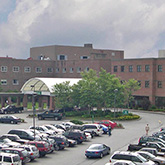Learn about Peripheral Vascular Disease and treatment options at Central Vermont Medical Center.
Request an Appointment
Request an appointment with a UVM Health Network – Central Vermont Medical Center cardiologist.
What is Peripheral Vascular Disease?
When blockages in the arteries occur that restrict blood flow to the limbs of your body, the condition is known as lower extremity peripheral vascular disease, or simply peripheral vascular disease (PVD). Atherosclerosis, the hardening and narrowing of arteries which impacts efficiency of blood flow, is the root cause of artery blockages. Since it develops progressively over time, patients don't show signs of the common symptoms for a few months or even up to a year. PVD is brought on by the following factors:
- Smoking
- High cholesterol
- High blood pressure
- Diabetes
- A family history of atherosclerosis, peripheral vascular disease or claudication
Peripheral Arterial Disease of the Legs
The area where this condition is most common is called peripheral arterial disease (PAD) of the legs. Similar to PVD, it is caused by a buildup of plaque within the arteries, restricting the blood flow to your legs. The muscles and other tissues are then deprived of oxygen. PAD and PVD are often used interchangeably when describing this condition.
Peripheral Vascular/Arterial Disease Diagnosis:
There are different levels of symptoms with varying severity that can occur when you have peripheral vascular disease/peripheral arterial disease. For example, you could have blocked arteries with no apparent symptoms, or blocked arteries with claudication, leg pain or cramping induced by exercise. In more severe cases, blocked arteries cause extreme pain in the feet and legs. Without proper treatment, the disease can impact the health of your limbs and lead to more debilitating symptoms with long-term effects.
The diagnosis process involves the following:
- Pulse volume recording. This measures the volume of blood at various points in your legs.
- Ankle-brachial index. A test that evaluates the circulation in the legs, by comparing blood pressure in the ankle and the arm.
- Duplex ultrasound. This technique involves the combination of both conventional ultrasound that shows the structure of the blood vessels with Doppler ultrasound, which allows for measurement of blood flow.
Treatment of Peripheral Vascular/Arterial Disease
The symptoms of peripheral vascular disease can be improved by a series of lifestyle changes. These include exercise, healthy eating, weight loss and quitting smoking. Medications can also help symptoms by reducing any pain the disease causes, improving blood flow and lowering cholesterol. In more severe cases, there are two main surgery procedures recommended. Angioplasty and stenting is minimally invasive and allows for arteries to be opened with a balloon, and propped open with the placement of stent so blood can flow more efficiently. Bypass surgery is performed to create a new pathway that diverts blood flow around the blocked or narrowed artery.
Chronic Venous Insufficiency
When the veins in the legs are unable to pump the sufficient amount of blood back to the heart, a condition occurs called chronic venous insufficiency. As a result varicose veins develop, enlarged and twisted veins that appear blue or purple. Healthy veins are able to create blood flow from the limbs and back to the heart. Valves within the veins prevent a backwards flow of blood. Venous insufficiency occurs when these valves are damaged and cannot function properly. Although there aren’t any serious health risks associated from chronic venous insufficiency, there are some risk factors. These include:
- Family history of varicose veins
- Older age
- Deep vein thrombosis (blood clot)
- Phlebitis (blood clots in superficial veins)
- Obesity
- Inactivity
- Pregnancy
- Smoking
Symptoms and Diagnosis of Chronic Venous Insufficiency
The most common symptoms indicating that you have chronic venous insufficiency are as follows:
- Ankle and leg swelling
- A heavy, tired or aching feeling in the legs
- Pain while walking or after being on one's feet all day
- Skin discoloration
- Skin ulcers
To confirm you have chronic venous insufficiency, the diagnosis process begins with a physical exam. A vascular surgeon will examine your varicose veins and measure the blood pressure in your legs for any irregularities. In order to confirm a diagnosis, a duplex ultrasound is performed to determine if your veins are functioning efficiently or if there are any signs of a blood clot. High-frequency sound waves bounce off cells and vessels, allowing doctors to look at an image of the structure of blood flow and blood vessels in your legs.
Treatment of Chronic Venous Insufficiency
The severity of your chronic venous condition and your overall health will determine the treatment plan that is best for you. Each form of treatment is prescribed to decrease the severity of pain and prevent the development of other issues like venous ulcers.
- Compression Stockings – When you have a more mild case of venous insufficiency, you can treat symptoms by wearing compression stockings daily. Their elasticity squeezes the veins to increase the blood flow in the legs and improve efficiency.
- Sclerotherapy – More serious cases of chronic venous insufficiency and varicose veins are treating with surgical procedures like sclerotherapy. This involves the injection of chemicals into the affected veins causing them to close off and allowing the body to eventually absorb them.
- Ablation (Closure) – This is another common outpatient procedure that is minimally invasive. Ablation involves the insertion of a catheter into the damaged vein. A radiofrequency energy is then emitted from the catheter, heating the vein wall to shrink it. This closes the damaged vein, allowing blood flow to be diverted to healthier veins and improving the efficiency of its circulation.
- Vein Ligation – Another method to close off the affected vein involves vein ligation. A small incision is made over the varicose vein to tie it off and interrupt blood flow. As a result, the vein shrinks and becomes absorbed into the body. Typically this is performed in addition to the ablation procedure, in order to effectively disrupt blood flow through affected veins.
To make an appointment with one of our specialists, please call 802-225-5660

CVMC Cardiology
Phone
Fax
802-229-9533
Hours
Monday:Phone Hours:
8:30 pm - 12:00 pm
1:00 pm - 5:00 pm

